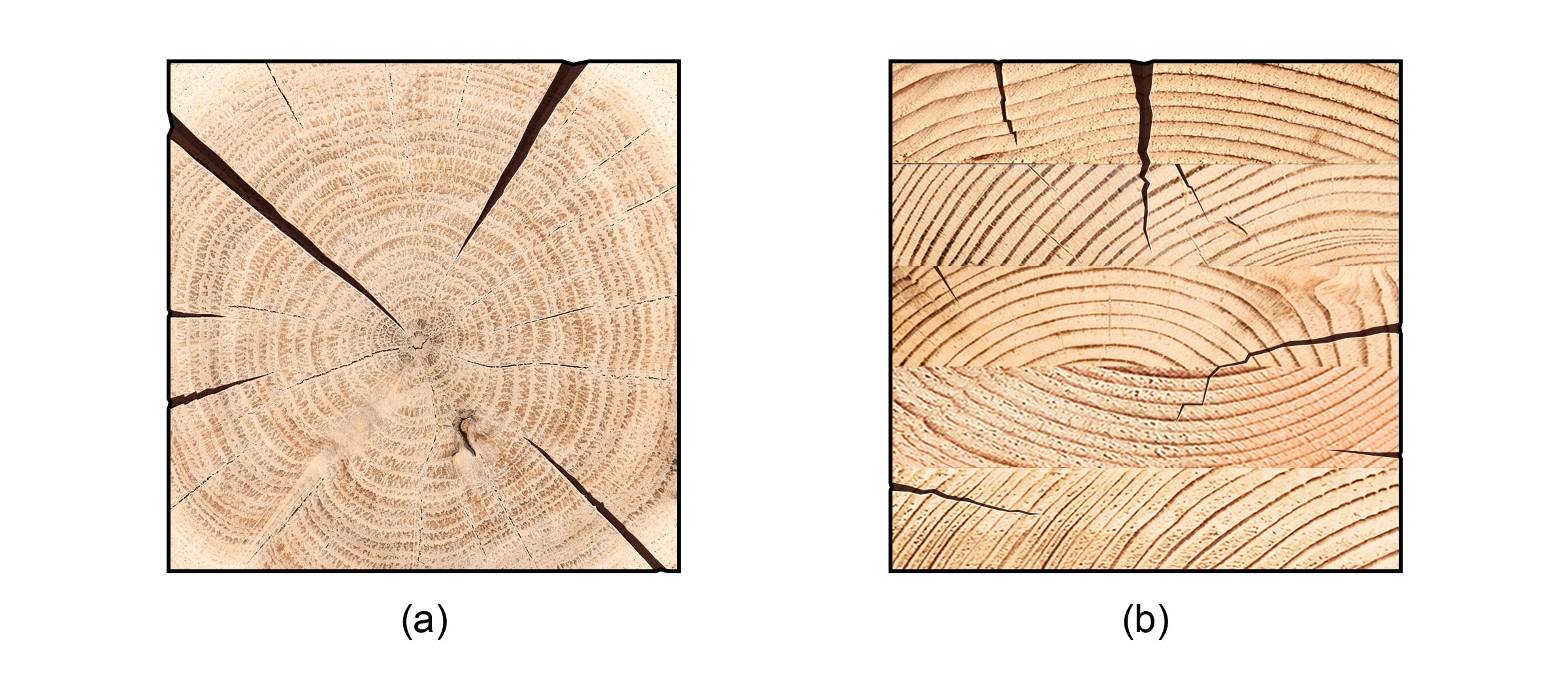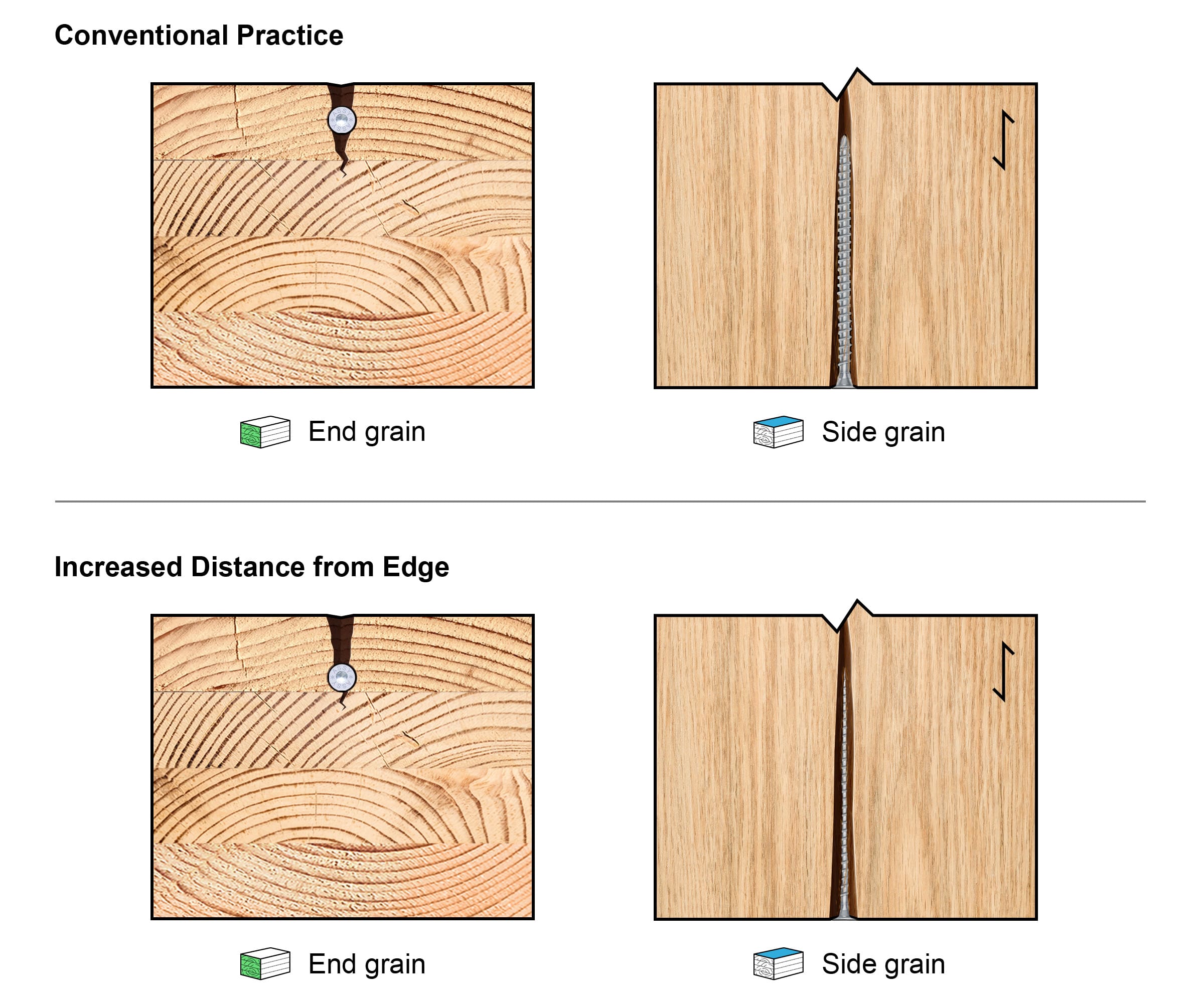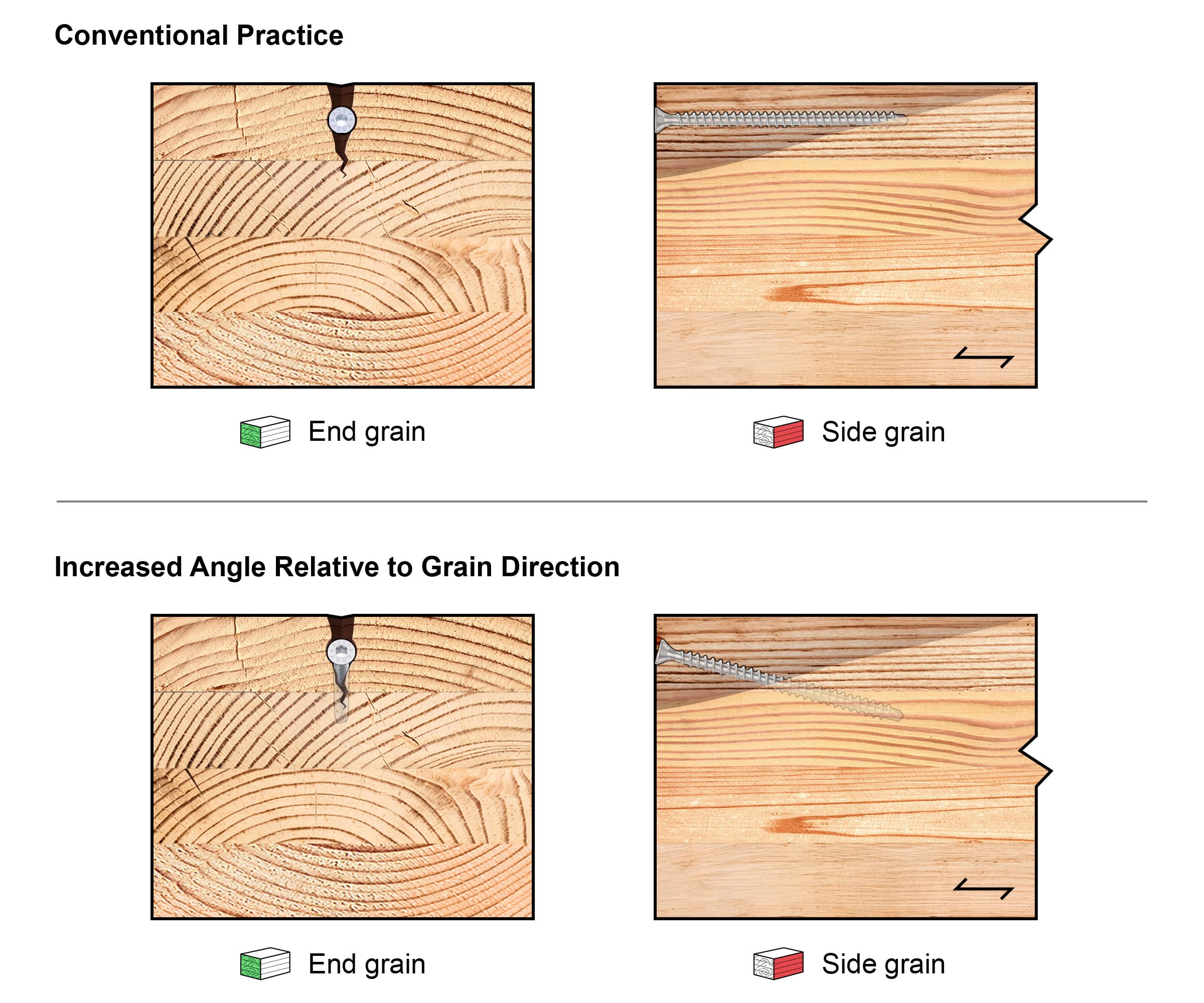Fasteners exhibit reduced withdrawal resistance when installed in the end grain of wood members. Such decrease results primarily from the lower availability of growth rings, particularly latewood that imparts higher capacity owing to its greater density, along this penetration path. Additionally, the reduction is influenced by the presence of end-grain checks—a natural seasoning characteristic of wood. The diminished capacity presents a considerable safety risk with potentially serious consequences. Despite this inherent challenge, certain situations necessitate such fastener placement, calling for consideration of measures to enhance withdrawal capacity. For end-grain applications under permanent withdrawal loading, for example, the engineering team at MTC Solutions recommends installing fasteners at an angle to the grain direction and at a distance from the edge, while ensuring a minimum thread penetration length and an adequate quantity. Moreover, maintaining control over wood moisture content is crucial to prevent significant variations that could result in further development and expansion of checks.
Approximately 7-min read.
Optimal withdrawal capacity is achieved when fasteners are installed perpendicular to the grain direction of wood members. In this arrangement, fasteners penetrate a large number of growth rings encompassing both earlywood and latewood. The latter, with its greater density, imparts a markedly stronger anchoring effect that directly contributes to higher withdrawal capacity. As the installation deviates from this perpendicular orientation, fasteners experience a decrease in withdrawal resistance due to the fewer growth rings—and consequently, fewer latewood layers—along their path. The extent of this reduction positively correlates with that of the deviation. Notably, as the angle of installation relative to the grain direction approaches zero, as seen in typical end-grain applications, the lowest withdrawal capacity is observed. For a more detailed explanation of withdrawal capacity reduction, please refer to the following white paper published by MTC Solutions:
The reduction in the withdrawal resistance of fasteners, when applied to the end grain, is further compounded by the presence of checks that manifest as cracks or splits, constituting a seasoning characteristic of wood. Arising from changes in moisture content, checking is a common phenomenon in both natural and engineered timber products, as illustrated in Figure 1. While this natural trait does not affect the structural properties of wood under most circumstances, it can significantly compromise fastener withdrawal capacity.

Figure 1. Checks in the end grain of (a) natural and (b) glued laminated timber products
Despite the decrease in resistance, certain scenarios demand the end-grain installation of fasteners in withdrawal. These include wood-to-wood T-joints and the application of rigging equipment in columns, as shown in Figure 2 (note that these connections are typically designed for use cases involving short-term loading only). Therefore, it is crucial to implement measures that help mitigate the risk of withdrawal failure in such cases.

Figure 2. End-grain applications of fasteners in withdrawal. (a) Wood-to-wood T-joint. (b) Column rigging equipment.
The likelihood of checks developing and expanding, and thus weakening fastener capacity, increases as the load exposure extends. This correlation is ascribed to the heightened probability of the wood member undergoing fluctuations in moisture content over a protracted timeframe. Consequently, appropriate mitigation measures should be selected based on the load duration.
Short-term loads
Under loads lasting less than 10 minutes, checking is unlikely to appreciably impair withdrawal capacity. Hence, ensuring a minimum thread penetration length of 20 times the nominal diameter of the fastener, denoted as D, generally suffices to achieve adequate withdrawal performance, even in cases of parallel-to-grain installation. Importantly, seeking validation of withdrawal resistance adequacy from a registered design professional is prudent.
Permanent (or standard-term) loads
In situations involving permanent (or standard-term) withdrawal loads, such as deadloads, adopting additional resistance-enhancing measures becomes imperative.
Distance from the edge
Checks typically exhibit a wedge-shaped form, tapering in size as they extend away from the edge of the wood member. Hence, positioning fasteners at a greater distance from the edge, as demonstrated in Figure 3, can improve their engagement with fibers, capitalizing on the increased fiber availability. This enhancement, in turn, augments their withdrawal capacity. This measure effectively mitigates the adverse impact of checks, particularly in instances where the parallel-to-grain installation of fasteners is a technical necessity.

Figure 3. Increase in fastener withdrawal capacity with an increase in the distance from the edge
Angle of installation
Compared to parallel-to-grain installation, inserting fasteners at an angle relative to the grain direction can similarly strengthen their withdrawal resistance, as demonstrated in Figure 4. This measure involves reducing the segment of fasteners within checks, where anchoring fibers are absent, while simultaneously aligning the fastener axis closer to the direction perpendicular to the grain—where maximum withdrawal capacity is attained. A minimum installation angle of 15° is recommended for scenarios demanding fastener placement near the edge of the wood member.

Figure 4. Increase in fastener withdrawal capacity with an increase in the angle of installation
relative to the grain direction
Minimum thread penetration length
A minimum thread penetration length of 20D is recommended for fasteners installed in the end grain and subjected to permanent withdrawal loads.
Research,[1] nonetheless, has indicated that achieving optimal results with fasteners installed parallel to the grain may call for a thread penetration length ranging from 24D to 32D, depending on the particular wood species, to take full advantage of their ultimate tensile strength.
Quantity
Findings from tests commissioned by MTC Solutions suggest the use of at least two fasteners, ideally four, to ensure sufficient end-grain withdrawal performance.
Moisture content
Finally, it is essential to carefully control wood moisture content to inhibit significant variations that may trigger the formation and enlargement of checks. Such occurrences can negatively impact fastener withdrawal capacity in end-grain applications.
By employing the measures presented above in concert, the risk of withdrawal failure in end-grain fasteners under permanent loading can be effectively minimized in disparate situations.
Several measures are available to improve the withdrawal capacity of fasteners installed in the end grain of wood members. For additional information and design guidance, please contact our Technical Support Team. 🙂
[1] Gutknecht, M.P., 2017. Parallel-to-grain withdrawal resistance of structural self-tapping screws in Canadian timber. Master’s thesis, Queen’s University (Canada).
Register for a Technical Learning Session
Sign up for MTC Newsletter and keep up to date with all our progress.